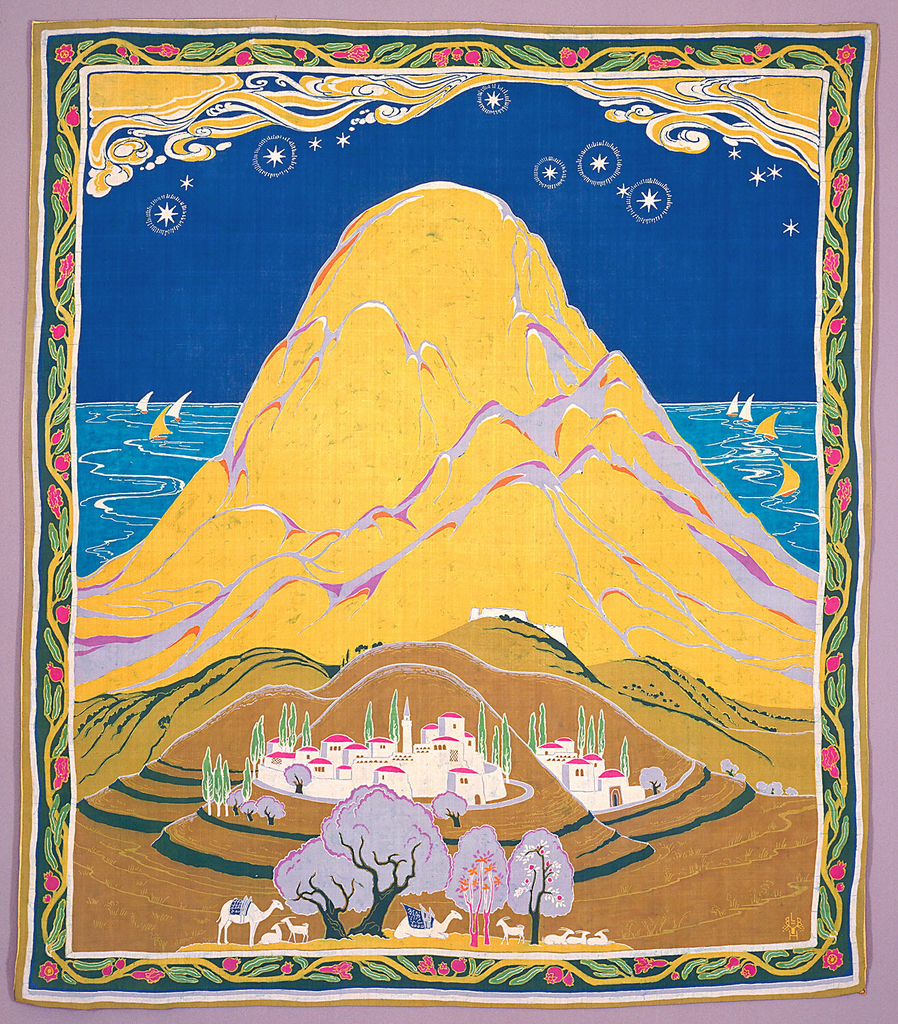Author: Erica Warren
In celebration of the fourth annual New York Textile Month, members of the Textile Society of America will author Object of the Day for the month of September. A non-profit professional organization of scholars, educators, and artists in the field of textiles, TSA provides an international forum for the exchange and dissemination of information about textiles worldwide.
Lydia Bush-Brown (American, 1887-1984), a well-travelled artist who reportedly spent over a year living in Syria in the mid-1920s, pictured landscapes familiar from her travels in silk murals. A prime example of Bush-Brown’s work, The Golden Mountain envisions a village set amongst terraced hills at the base of the eponymous mountain. Although her picturesque murals feature idealized representations (see also Bermuda and Temple of the Mayan Indians) the landscape featured in this work may be based on a particular day’s venture, as reported by Mrs. Stuart Bone, an avid archaeologist. Bone’s report of her explorations with Bush-Brown from July 15, 1925 speak to the scene depicted, “we saw on two neighboring hills on the south side of the road the remains of a couple of settlements. What catches one’s eye from the road is a line of grey walls against the sky line surmounted by a row of the square window spaces which are a feature of all the buildings in the district.”[1] Although in the hanging the two settlements on neighboring hills are white, rather than grey, this artistic choice aligns with Bush-Brown’s often expressionistic approach to color, also evident in the lilac hue she employed for the foliage of several trees that dot the landscape.
Prior to her travels, examples of Bush-Brown’s early works were featured in exhibitions and publications, and during the late 1920s, her silk murals were displayed across the United States, in cities such as Boston, Chicago, New York, Philadelphia, and Washington D.C.[2] In a conversation about her “silk mural paintings,” Bush-Brown explained her material choice, “Silk to me is the ideal foundation for murals for our modern homes. It fits into all types of homes, from the simplest to the most luxurious, is easy to transport, hangs gracefully and is capable of taking any color scheme desired.”[3] Her thoughts on interior decoration speak to a larger interest, on the part of a group of American artists, to continue to conceive of the modern home as an artistic environment. Indeed, contemporary appraisals of her work situate her within this milieu, and one critic even commented “she has contributed to current decoration while producing works of art.”[4] Immersed in the art world since birth, as the child of two artists, Bush-Brown’s circumstances fostered the flourishing of her artistic career.
Erica Warren is assistant curator in the Department of Textiles at the Art Institute of Chicago.
[1] Mrs. Stuart Bone, “A Day among the Ruins of the Fifth Century Churches near Antioch” Bulletin of the American Schools of Oriental Research no. 22 (April 1926): 6-7. It is clear that Bush-Brown documented this particularly excursion as the journal editor, in the introduction to Mrs. Bone’s report, noted “we only regret that the drawings prepared by [Miss Lydia Bush-Brown] we have not space to present.”
[2] Elisabeth Spalding, “Old and Modern Handicrafts: An Exhibition Held in Baltimore” Art and Progress 4.7 (May, 1913): 963, and Ruth K. Rice, “An Individual Craft” Art World 3.3 (December 1, 1917): 257.
[3] Lydia Bush-Brown quoted in Ester Coster, “Developed Silk Mural Painting” The Brooklyn Daily Eagle (15 January 1928): 10 [or 84).
[4] Babette M. Becker, “Silk Murals of Lydia Bush-Brown” The American Magazine of Art 10.10 (October, 1928): 556.

2 thoughts on “Lydia’s Textile Travels”
Dorothy Carney on September 11, 2019 at 1:29 pm
Could someone share just a few words about how Bush-Brown’s silk murals were created. Were they painted on custom woven panels. Did the artist do the weaving. What is the media of the drawing on the silk.
Thanks.
Erica on September 11, 2019 at 3:43 pm
Bush-Brown created her silk murals with batik, a technique explored in relation to another example of her work also in the Cooper-Hewitt’s collection, https://collection.cooperhewitt.org/objects/18482921/.